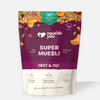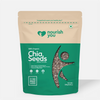
Leather: what is it? how is it made? Is it vegan?
Many people who wear leather aren't aware that animals have to be slaughtered in order to produce it, while others believe that their purchases are good because they’re using parts of an animal after they're slaughtered for food.
But it’s not harmless: it’s a brutal industry, separate from the meat industry. Just because leather is not an edible product, doesn’t mean animals aren’t killed to make it.
A Cruel Commodity
Leather is a multi-billion dollar business worldwide, and it’s one of the most widely traded items in the world. It may be hard to believe, but India supplies up upto 13 percent of the world’s total production of skins. Slaughtering domestic cattle is punishable by law in most states, but India exports a large amount of leather to international markets, with the European Union buying about 52 percent of India’s total export of leather and leather products.
Despite the taboo of slaughtering cows, their economic value outweighs their sacredness as society’s primary source of products like milk and beef. Leather is even more valuable, since it’s not subjected to expensive food safety testing or costly food storage.

The Process Of Making Leather
Since Kerala and West Bengal are two of the few states that have no ban on cow slaughter, this is where much of the leather making process happens. But to keep up with demand, there are many illegal slaughterhouses operating all over India.
It’s no surprise, then, that the conditions of the animals are horrible. Terrified cattle are packed into trucks so tightly they cannot move, and the journey to the slaughterhouse can take several days—in which they have no access to food or water.
Cattle also have to endure long and painful journeys as they're led to slaughterhouses or processing facilities where they can be killed. They’re tied together and forced to run through the scorching heat and dust without any food or water. If any individual grows weak, as many do, their tails are either broken or their eyes are rubbed with tobacco or chilli peppers to force them to get up and keep walking. They’re pushed beyond their physical limits, causing many of them to collapse or die before reaching the final destination where they’re ultimately killed.
To keep costs down, cows are brutally killed without anaesthesia, and they're often skinned alive. After they’re slaughtered, hides are transported to other states like Tamil Nadu with a large concentration of leather product factories. India’s spread out network of cattle farmers and slaughterhouses makes it very hard for leather companies to trace the supply chain.
Even if Indian leather could be traced back to a family farm you know and trust, it’s cruel to kill an animal for products we don’t need. If you're vegan or planning on being one, you may be wondering what to do with your old leather clothing.
To begin with, you can stop purchasing leather products to reduce the demand for them. And as a role model you have an opportunity to influence others by not purchasing or wearing leather.
If you already own second-hand leather products or plan to purchase them in the future, it can actually be harmful by inspiring others to purchase a new leather shoe or jacket. Here are some things you can do instead:
- Donate your items to people who can’t afford to buy clothing for themselves, particularly in colder regions
- Donate items like jackets to an animal shelter to be used as bedding. Or, if you have a pet, you can use it in your home as bedding
- If you wish, you can bury your items or dispose of them in the trash
- Buy vegan leather instead!
Leave your thoughts below, and don’t forget to share!










Comments
Leave a comment